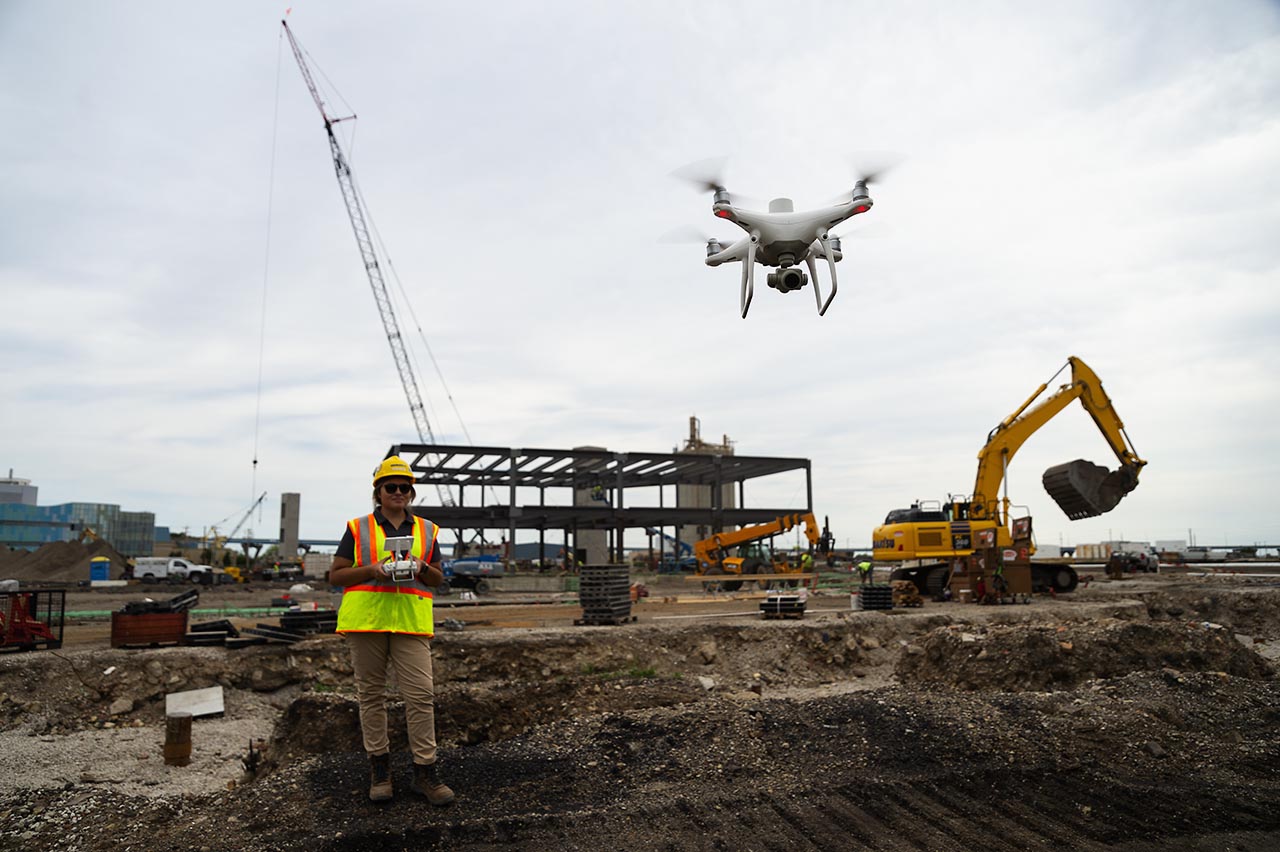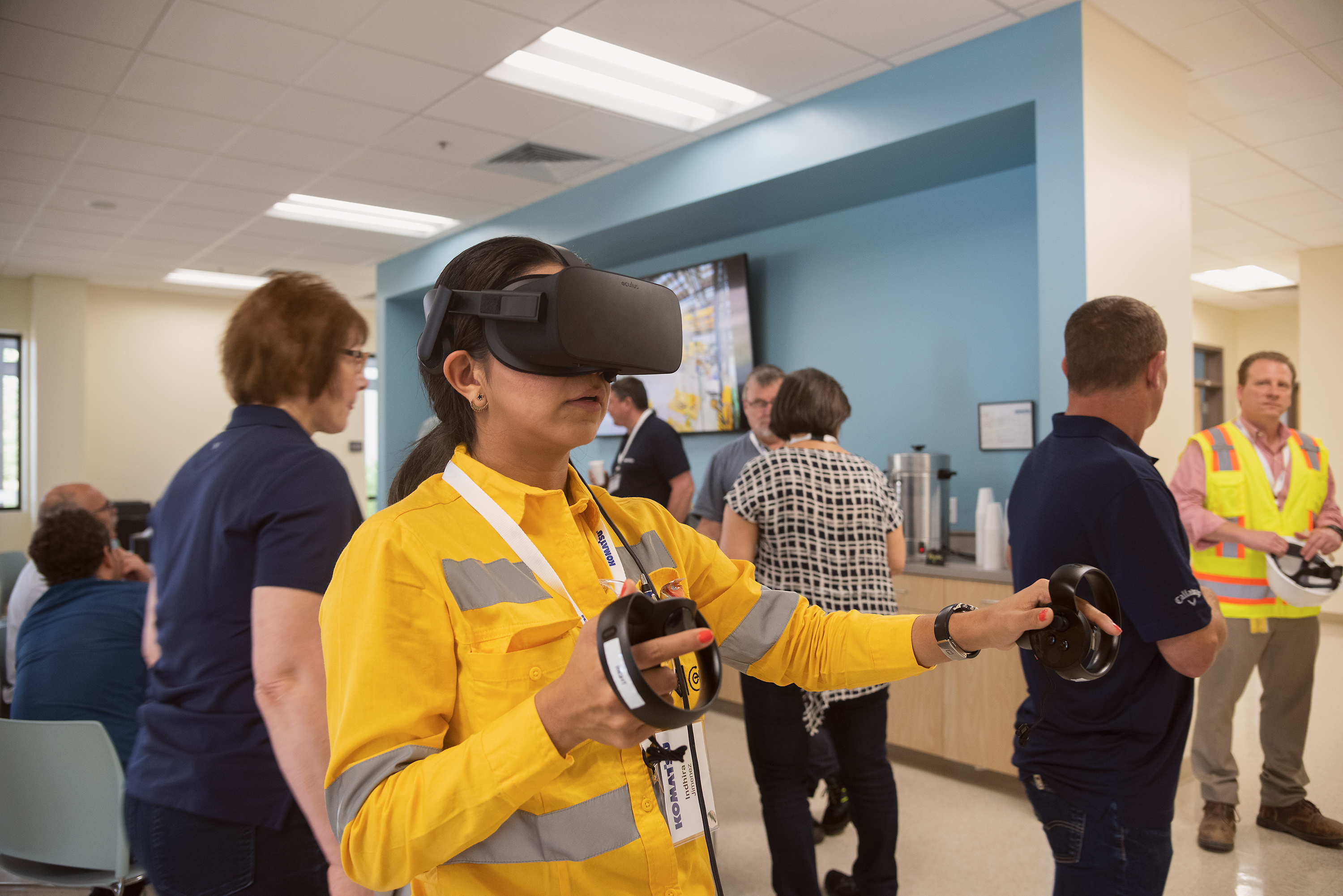2 min read
Komatsu named a Best of CES winner
- Press release,Construction,Company,Surface mining
8 min read

It’s no secret that technology in construction is trending. U.S. construction technology investor funding reached a record $2.1 billion in early October 2021. That is more than a 100% increase from 2020. Construction companies across the world are adopting technology at a rapid pace as they look to gain efficiency and increase productivity while lowering owning and operating costs.
Technology, however, can refer to a vast number of things. Toward what tech trends is all of this funding going? Which technologies are changing the construction landscape today, and what are the forces behind this upward trend?
Trending technologies don’t always mean they are new. For example, lidar (light detection and ranging) has been around since the 1960s but has only recently become extensively used in construction.
Lidar is a popular remote sensing method used for measuring the exact distance of an object on the earth’s surface. Lidar’s x, y and z coordinates make it incredibly easy to produce 3D elevations that ensure that concerned parties can easily draw necessary conclusions. More and more, construction companies are using lidar videos to map terrain elevations and build models for roads, parking lots and buildings.
“We use lidar scanners on tripods or drones to shoot out about 1 million points of light per second,” explained Ken Smerz, CEO of Zelus, a firm that specializes in building information modeling (BIM) and virtual design and construction (VDC). In the article "Here’s how advances in technology are transforming construction industry," Smerz continues, “ Whenever a laser touches something, its light bounces off the surface and back into the scanner. It’s the same technology that police officers use to see if you’re driving too fast, but it’s just recently been used in the construction field.”
Drones equipped with lidar can fly over a site and collect data that can be used to build 3D models. This fast and accurate way of surveying a site provides several benefits, according to Dustin Price, a licensed land surveyor and operations manager at Landpoint LLC. In his blog post “Lidar Inspections Improve Construction Safety,” Price points out lidar is beneficial because it:
 To gain efficiencies and increase productivity, while lowering owning and operating costs, construction companies across the world are adopting technology. Drones equipped with lidar (light detection and ranging) can fly over a site and collect data that can be used to build 3D models. Lidar is just one of many technologies trending in today’s construction industry.
To gain efficiencies and increase productivity, while lowering owning and operating costs, construction companies across the world are adopting technology. Drones equipped with lidar (light detection and ranging) can fly over a site and collect data that can be used to build 3D models. Lidar is just one of many technologies trending in today’s construction industry.
Owners, architects and contractors use BIM (building information modeling) to collaborate on design and construction at each phase of the project. According to Whole Building Design Guide (WBDG), which is managed by the National Institute of Building Sciences, BIM is a digital representation of physical and functional characteristics of a facility. It serves as a shared knowledge resource for information and provides a reliable basis for decisions during a project’s life cycle.
“A basic premise of building information modeling is collaboration by different stakeholders at different phases of the life cycle of a facility to insert, extract, update or modify information in the model to support and reflect the roles of that stakeholder,” WBDG states. “The model is a shared digital representation founded on open standards for interoperability.”
Commonly listed advantages from experts who use BIM include improved communication and coordination, cost and resource savings, higher quality results, early identification of potential problems, and increased safety.
“BIM relies on a ‘single source of truth’ system; this means that all the relevant information — including models, estimates and design notes — are shared and stored from one place,” wrote Nash Reyes, director of digital practice for HMC Architects, a leader in BIM. “Everyone involved in the project can see the information and even offer suggestions of their own. It’s a true collaboration that eliminates information silos and helps architects find the best solutions based on data analytics.”
In its earliest inception, manufacturers used telematics to find information such as location and fuel usage of machines. Now, telematics provides manufacturers with more comprehensive tracking data, including production numbers and machine health.
But, what about the health and safety of workers? Some telematics can also provide ways to monitor that critical information with the use of wearable technology, while also increasing productivity and monitoring capabilities.
Top wearable items include smart helmets that provide 360-degree views of your surroundings and offer direct communication among workers; smart safety vests with enabled tracking and remote communication capabilities; smart glasses that let workers access plans and take progress photos; and smart work boots with tracking capabilities and wearable sensors that detect falls and trips and can automatically alert others if a worker is hurt or in an area that has been designated as unsafe.
Virtual reality (VR) and augmented reality (AR) headsets could also be considered wearable. Companies are using these high-tech devices throughout the construction industry for operator training. Until they gain some proficiency, these high-tech devices allow a wearer to mimic the movement of construction equipment without having to be on an actual job site.
 Research by The Wall Street Journal analysts found that the 20 most diverse S&P 500 companies generally performed better financially over five- and 10-year periods. A McKinsey & Company report showed that the greater the diversity, the higher the likelihood of outperformance.
Research by The Wall Street Journal analysts found that the 20 most diverse S&P 500 companies generally performed better financially over five- and 10-year periods. A McKinsey & Company report showed that the greater the diversity, the higher the likelihood of outperformance.
Jim Colvin, president and CEO of Serious Labs Inc., a technology company that develops VR training solutions for the global heavy equipment industry, said this type of education helps trainees advance skills faster and more effectively than traditional methods.
“Engaging people can be incredibly challenging because it is difficult to keep people’s attention,” said Colvin during his presentation “Virtual Reality, Augmented Reality and the Future of Work: Are You Ready for the New Realities?” at CONEXPO-CON/AGG 2020. “The best thing about realistic training environments is that we can pretty much create an experience that feels like real life, all for the purpose of training.”
Much of today’s technology needs connectivity, whether it is sending plans back and forth when working with a BIM model or accessing data from a safety vest. Growth and adoption of the Internet of Things (IoT) helps make that more possible.
The IoT refers to the billions of physical devices around the world that are now connected to the internet, all collecting and sharing data. In construction, it involves the use of internet-connected sensors, which are placed around job sites or worn by laborers.
In general, construction companies can benefit from IoT because it can provide improved resource management, better reporting and maintenance, increased speed in reacting to changes, and overall cost savings. IoT can present some disadvantages as well such as the potential for data breaches, too much of a dependence on technology, complexity and privacy concerns, but the benefits tend to out outweigh the concerns.
Advancements in technology are the primary force behind today’s construction technology boom, but unsurprisingly, COVID-19 also played a big role in the recent, rapid adoption (i.e., construction tech investments increasing more than 100% in a year). Digital collaboration, safety and wearables, and BIM were among the construction tech categories boosted by the pandemic, according to JLL, a global real estate services company.
“Our take on what happened was that basically two- or three-years’ worth of construction tech adoption got squeezed into nine months post-pandemic because everyone shifted to being off-site, socially distancing and virtual tools,” said Henry D’Esposito, JLL’s construction research lead. “If you see rising adoption numbers, new customers, and more profitability, then that gives investors a good reason to want to invest in a sector.”
While some construction companies are quick to pick up on technology trends, others are more hesitant to adopt. After all, it takes time and money to change processes and products.
For hesitant companies, Komatsu’s Bryce Satterly, Komatsu Smart Construction solutions manager, emphasizes that it’s well worth the investment because soon, construction companies might need technology to survive.
“It’s been said for some time that if you are not adopting technology, you are falling behind, and that’s true,” Satterly said. “Companies using GPS grade control, intelligence and telematics for tracking are ahead of the curve. These technologies are proven to save time, increase productivity and efficiency, and reduce owning and operating costs.”
Using drones to survey and map job sites and track progress in near real time and telematics to assist in fleet management have become commonplace,” Satterly continued. “Even if they are not using them to their full capabilities yet, most contractors know what these items are.”
Adopting technology may seem intimidating, but it doesn’t have to be, according to Damon Haber, co-founder and chief revenue officer at Record360, which helps businesses add the latest products to their operations.
“I was an operator before I became a tech guy, so I understand how it is affecting companies and individuals,” Haber said. “Like equipment, devices and apps don’t create outcomes; however, they can be valuable tools that help achieve them. Failures often happen when companies try to do too much or have no clear objectives as to why they want to implement certain solutions.”
Haber said there are some best practices for introducing technology: start small, set measurable goals and outcomes, and secure commitments from end-users.
“You can always get bigger,” Haber emphasized. “Before full implementation, it’s wise to do a pilot study, and do it well. You should also look at today’s modern solutions and see how they can flex to match desired goals.”
Learn more about how Komatsu is advancing construction technology through its Smart Construction suite of solutions.